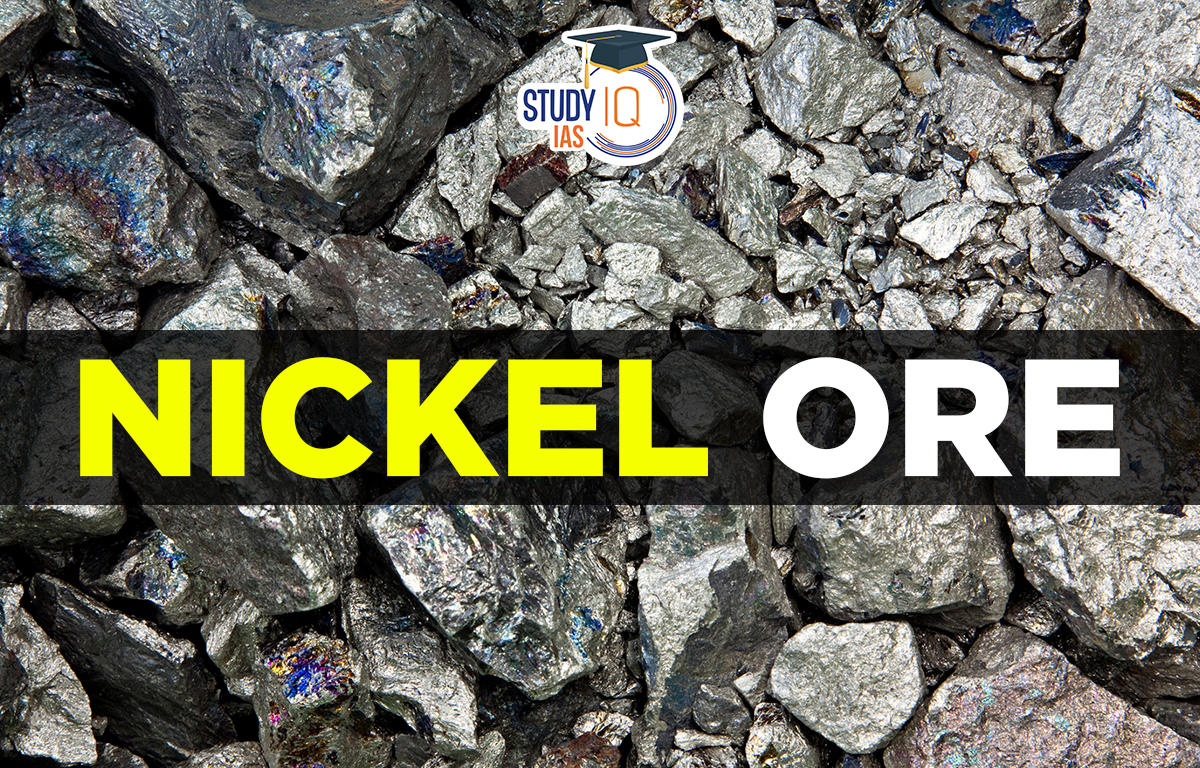Table of Contents
Nickel Ore
Pentlaudite (a mixture of nickel, iron, and sulfur) is Nickel Ore. It is very hard and resistant to erosion. It is also very ductile and malleable. Another source of nickel is polymetallic sea nodules. Odisha has roughly 92% of the resources. Iron ore limonite, which contains 1-2% nickel, is an economically important source of nickel. The remaining 8% of the resources are allocated to Jharkhand, Nagaland, and Karnataka.
Nickel is a hard, silvery-white metal. Nickel does not occur naturally. It is found in association with copper, uranium and other metals. It is an important alloying element.
Read about: Iron Ore
Nickel Ore Distribution in India
The Sukinda valley in the Jajapur district of Odisha has significant occurrences of nickeliferous limonite. It appears as oxide here. Nickel occurs in sulphide form alongside copper mineralization in Jharkhand’s east Sighbhum district. Furthermore, it has been discovered in association with uranium deposits in Jaduguda, Jharkhand. Nickel is also found in significant quantities in Karnataka, Kerala, and Rajasthan.
Read More: Manganese Ore
Nickel Distribution in World
Indonesia is the world’s largest producer, followed by the Philippines and Russia. Australia has the highest reserves, followed by Brazil, Russia, and Cuba.
| Country | Regions |
| Indonesia | Sulawesi, Celebes |
| Philippines | Rio Tuba |
| Australia | Queensland and Kalgoorlie |
| Canada | Sudbury, Lynn Lake |
| CIS | Sverdlovsk and Orsk in the Urals, Kola Peninsula, Norilsk in Siberia. |

Read about: Chromium Ore
Nickel Properties
- Nickel ore is usually found as a sulfide or laterite and contains an average of 1-2% nickel.
- It is tough and has high tensile strength. As a result, nickel steel is used to make armoured plates and bullet jackets.
- The hardness of nickel ore varies depending on the type and specific mineral content but typically ranges from 4 to 6 on the Mohs scale.
- The specific gravity of nickel ore ranges from 2.5 to 4.5, depending on the type and mineral content.
- Some nickel ore may exhibit weak magnetic properties, depending on the mineral content.
- Nickel ore has good thermal and electrical conductivity.
- Nickel ore is not highly reactive, but can react with strong acids and oxidizing agents.
- Nickel ore can range in colour from silver to black, depending on the type and mineral content.
Read More: Cobalt Ore
Nickel Uses
- Coins are made of nickel, copper, or silver. Nickel has a long history of use in coinage. The five-cent piece (known as a “nickel”) in the United States comprises 25% nickel and 75% copper.
- Nickel is corrosion-resistant and is used to safeguard other metals by plating them.
- Nickel is used in batteries. For example, rechargeable nickel-cadmium batteries and nickel-metal hydride batteries in hybrid automobiles.
- Nickel-aluminum alloys are used in the production of aircraft and internal combustion engines.
- Metallic nickel is used in the production of storage batteries, as a catalyst for the hydrogenation or hardening of fats and oils for use in soap and food, and in the production of vanaspati.
Read More: Types of Resources
Nickel UPSC
Nickel is a compound found in very low concentrations in the environment. Humans use nickel for a variety of purposes. The most common use of nickel is as an ingredient in steel and other metal products. Nickel can enter the body through the air we breathe, the water we drink, the food we eat, and the cigarettes we smoke. Nickel exposure can also occur through skin contact with nickel-contaminated soil or water.
Nickel is naturally present in foods in trace amounts. Chocolate and fats are known to have extremely high amounts. When people consume large amounts of vegetables grown in polluted soils, their nickel intake will increase. Plants are known to accumulate nickel, so vegetable nickel uptake will be significant.
Read about: Energy Resources





















 WhatsApp
WhatsApp